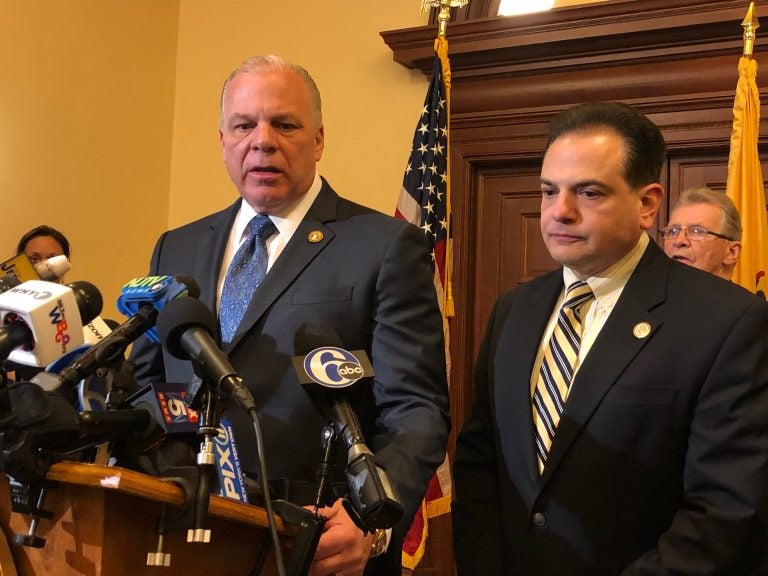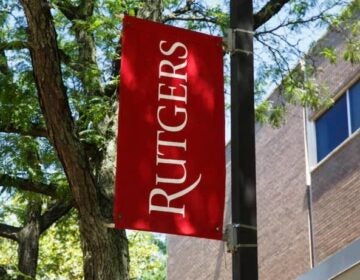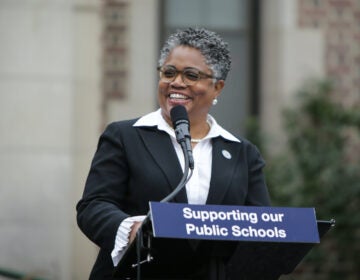Sweeney wants $50M extra for special ed but no more funds for losing districts
The increase would for students with the greatest needs. Senate president says districts facing steep cuts in state support shouldn’t expect additional aid.

State Sen. President Steve Sweeney, left, said he wants $50 million in the state budget for fiscal year 2020 to go toward so-called extraordinary aid for special education students (Joe Hernandez/WHYY)
This article originally appeared on NJ Spotlight.
—
Senate President Steve Sweeney yesterday had some good financial news — and some not-so-good financial news — for New Jersey’s public schools as they face the next fiscal year.
In an interview with NJ Spotlight staff, Sweeney said he will propose an additional $50 million in the state budget for fiscal year 2020 to go toward so-called extraordinary aid for special education students with the greatest needs.
The bump would be in addition to a $206-million increase in overall school aid already proposed by Gov. Phil Murphy, making the $15 billion allocated to education the largest slice of the governor’s $38.9 billion FY2020 budget proposal.
Sweeney said the $50 million addition would be the first of four equal installments that would close the gap on the state’s obligation to pay the extra costs for students requiring the greatest services. The allocation would go to supporting students where the cost exceeds $55,000 per year, Sweeney said.
With the increase, the line item would cost $250 million a year in next year’s budget and close to $400 million in four years for extraordinary aid.
“What I’d like to do is 50-50-50-50 to get to the $200 million needed,” he said. “It would help every school district in the state as we are making adjustments elsewhere in aid. Every school district will benefit from that.”
The not-so-good news was that this would be the last of the additional aid that Sweeney said he would agree to for education this year, despite the outcry from districts facing steep cuts in state support under his and Murphy’s agreement to fully fund the state’s school funding act within seven years.
Districts ‘way overfunded, spent every single penny’
Under Murphy’s proposed budget, a majority of districts would see increases in aid next year, but close to 200 would see cuts, in some cases deep ones. Several have said those cuts in turn would lead to program cuts and layoffs, including in Toms River and Jersey City, two of the state’s largest school districts.
That doesn’t mean there may not still be some rescue effort by the Murphy administration for those districts, but without Sweeney’s consent, it would be unlikely to get the Democratic-led Legislature’s approval.
“For nine years, school districts were way overfunded, spent every single penny they got and didn’t save anything,” Sweeney said. “They knew this had to end at some point.”
He said he might consider some flexibility in the state’s property-tax levy cap, allowing districts that are set to receive less state aid to tax above the current 2-percent limit to make up for the cut without going to the voters, as now required.
“I would be willing to raise the cap, even though they have the ability right now to go to the taxpayers to adjust their funding,” he said. “They can do that without me doing a thing. They don’t want to do that; they want me to do it for them.”
Sweeney stressed repeatedly that he was not straying from the path that he and Gov. Phil Murphy agreed to last year and that is continuing this year. When asked whether it could be a bargaining chip in budget negotiations in the next month, the Senator was unequivocal.
“Not a chance,” Sweeney said. “We told them when we signed this that this is not changing, this is it now. We’re sticking to it.”
WHYY is your source for fact-based, in-depth journalism and information. As a nonprofit organization, we rely on financial support from readers like you. Please give today.




